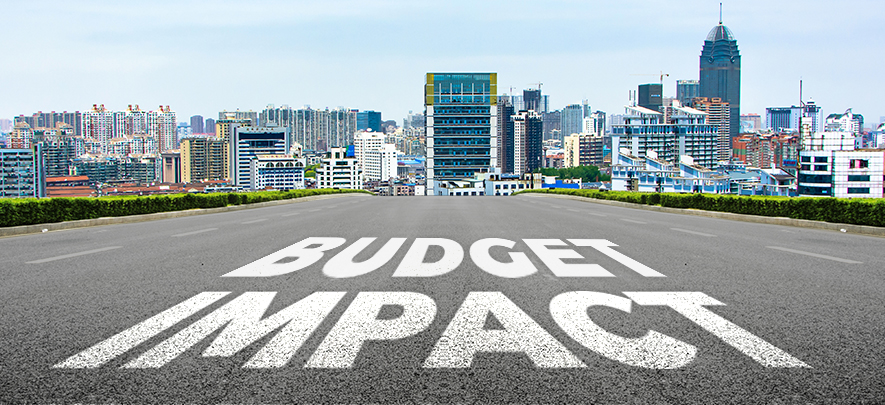Impact of budget 2019: The road ahead for key industries

Economy
321 week ago — 8 min read
The budget presented on 1 February 2019 came weeks ahead of the general elections and was interim in nature. The Finance Minister, in the budget announced that we are poised to become a five trillion-dollar economy over the next five years. Currently, India is the world’s sixth largest economy and this growth is driven by various industry verticals. So, how does the budget 2019 impact five key industries? Let’s find out.
1. Business & Technology
‘Digital India’ was a campaign launched with a vision to digitally empower every citizen and make information digitally available for all. The budget revealed some measures that will impact business and technology in India.
Businesses
- GST Filing for Small Businesses: Exemptions from GST for small businesses has been doubled from INR 20 lakhs to INR 40 lakhs. Businesses with less than INR 5 crore turnover can file for quarterly returns. As this section comprises of more than 90% tax payers, it will be a significant relaxation for them.
- Grant on loan: A 2% interest subvention on loan of INR 1 crore will be made available to MSMEs.
- GST: GST has been consistently reduced resulting in flow of nearly 80,000 crore rupees to consumers. Most items purchased by the poor and middle class will fall under the 0-5% tax bracket.
Technology
- Artificial Intelligence (AI): The government has plans to launch a National Artificial Intelligence Portal in the country. India has the capability to be amongst the global leaders on the world map and large scale adoption of technology and AI can help achieve that goal.
- Digital tax administration: Assessment of all tax returns will be done online within the next two years. Direct tax collections from 6.38 lakh crore in 2013-14 to almost 12 lakh crore and tax base up from 3.79 crore to 6.85 crore. All income tax returns will be processed within 24 hours. Technology can increase tax compliance, tax base and eventually, tax collections.
- Increased IT budget: Plans to invest more in security and cloud services.
- The government proposes to convert one lakh villages into 'Digital Villages' over the next five years.
Impact: The relief on GST for SMEs will encourage more enterprises to register. This will further bring the marginalized businesses under the fold of formal credit and promote GST adoption within the country. The launching of the AI portal will benefit five major sections, the healthcare, education, agriculture, smart cities and smart transportation namely.
2. Agriculture
The agriculture sector is the key driver of the Indian economy. Unfortunately, due to lack of proper income and means, farmers adversely impacted as a result of which the entire agriculture industry remains a distressed one.
To solve the agrarian crisis, the government announced the following measures:
- Income of all the farmers have been doubled: An income support scheme was introduced for farmers, the Kisan Samman Nidhi scheme. A huge outlay of INR 75,000 crore for financial year 2019 and INR 20,000 crore for financial year 2018 (starting December 2018) was announced under this scheme. This means farmers holding less than 2 hectares of land will receive INR 6,000 annually, in 3 installments, directly transferred to their jan dhan account, a commendable & progressive move.
In addition to this, farmers affected by natural calamities will be given 3% interest subvention on crop loans.
- All 22 crops will be covered under the Minimum Support Price (MSP) scheme (14 crops of the kharif season and 6 Rabi crops)
Impact: More than half of Indian farmers fall into small and marginal earners who earn around INR 35,00 to 40,00 per year. Their average land holding is around 2-10 hectares. They are frequently affected by natural calamities like floods and drought. These reforms, especially the Direct Transfer Benefit of Rs. 6000/ year to 12 crore farmers, will have a very strong positive impact on the rural economy. Also, subsidies provided by various other schemes of different states will have a cumulative effect on the agricultural produce.
3. Healthcare
Healthcare is also one of the largest sectors of the Indian economy. The following measures were mentioned that could be in favor of the health and wellness industry:
- Reduction in cost of medicine: The government had earlier taken initiatives to reduce the cost of medicine to provide quality treatment to the poor and underprivileged section of the society. Lakhs of people have been benefited so far. Finance Minister Piyush Goyal explained that private health care firms and pharmaceutical business owners can support this mission further by providing good quality medicines at low cost.
- 22nd AIIMS in Haryana: After successfully operating 21 AIIMS (All India Institute of Medical Sciences) across the country, the government announced that the 22nd AIIMS will be set up in Haryana.
- Ayushman Bharat: Prime Minister Narendra Modi’s flagship healthcare programme had provided treatments to nearly 50 crore people from 10 crore families in India. To cover the entire Indian population, the government would require additional assistance from private healthcare providers.
- The government also proposes to launch a mega pension yojana namely 'Pradhan Mantri Shram-Yogi Maandhan' for the unorganised sector workers with monthly income up to INR 15,000. This pension yojana shall provide them an assured monthly pension of INR 3,000 from the age of 60 years on a monthly contribution of a small affordable amount during their working age.
Impact: The government announced “healthy India” as a part of its future vision and these programmes will benefit the poor and below poverty line people, who can’t afford basic healthcare, to a great extent. Setting up of the 22nd AIMS will also generate jobs and business opportunities in different regions.
4. Education
The education industry has developed manifold since the past few years.
- National Education Mission: The government plans to invest nearly INR 38, 572 crores under this mission. The education budget has been increased to INR 76,800 crores in the financial year 2019-2020.
Impact: A greater spend on the education budget will mean better pay for teachers and increase in skilled educators. It will strengthen the internal capacity of central government schools. Focus is also to promote research facilities in schools. With a thrust on digitalisation, teaching methods will become digital in nature and education will become accessible for all.
5. Banking & Finance Sector
The government wants banks to earn more profits and deliver better efficiency. Here are the major takeaways for this sector from the budget:
- TDS exempted from bank interest: The TDS limit has been raised to INR 40,000 on bank and post office deposits. Deposit holders whose income is less than INR 40,000 won’t have to pay any income tax.
- Debt-GDP ratio: The government has proposed to consolidate debts to bring down the debt-GDP ratio to 40% by 2024-2025.
- Interest subvention during natural calamities: Interest subvention of 2% during natural calamities through the tenure of the loan (earlier it was just one year) and repayment of incentive of 3% has also been extended for the entire lifetime of the loan.
- Jan Dhan Yojna: Nearly 34 crore bank accounts have been opened and the government plans to bring up that number.
Impact: Financial services such as pension, remittances and credit insurance will become more affordable. Tax exemption will lead to greater savings for people.
Share your thoughts on the impact of the budget 2019 in the comments section below.
Posted by
GlobalLinker StaffWe are a team of experienced industry professionals committed to sharing our knowledge and skills with small & medium enterprises.
View GlobalLinker 's profile
Most read this week
Trending
Ecommerce 7 days ago













Comments
Share this content
Please login or Register to join the discussion